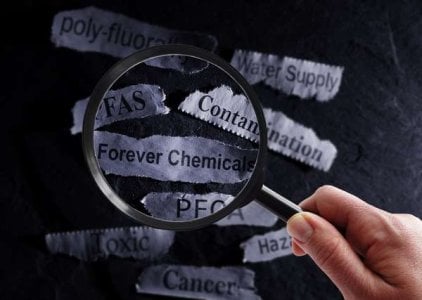Australia tightens drinking water guidelines amid ‘forever chemicals’ contamination concerns
- Replies 45
The safety of our drinking water is something we often take for granted, especially in a country like Australia, where we pride ourselves on our clean environment and high standards of living.
However, recent concerns over the presence of potentially cancer-causing chemicals in our water supply have prompted a significant overhaul of national drinking water guidelines.
This move has sparked a mixture of relief and apprehension among Australians, particularly those over 60 who are more vulnerable to health risks.
The chemicals in question are known as PFAS (per- and poly-fluoroalkyl substances), a group of over 15,000 synthetic compounds that have been widely used for their resistance to heat, stains, grease, and water.
These ‘forever chemicals’ have earned their nickname due to their persistence in the environment and the human body, where they do not readily break down.
The widespread use of PFAS, ranging from firefighting foams to non-stick cookware, has led to their detection in water sources, raising alarms about the potential health impacts.

In response to these concerns, the National Health and Medical Research Council (NHMRC) has released draft benchmarks that tighten the guidelines for PFAS levels in drinking water.
These ‘very conservative’ proposed guidelines are based on emerging science that highlights the health risks associated with PFAS exposure, including cancer.
While Australian experts and the water industry have welcomed the new benchmarks, there has been some criticism that the NHMRC's guidelines are not as stringent as the near-zero levels recently set by the United States Environmental Protection Agency (EPA).
Water quality expert and Head of the University of Sydney School of Civil Engineering Stuart Khan assured Australians that the national guidelines for drinking water safety are based on the latest and most rigorous scientific research.
However, he cautioned that upgrading treatment plants to comply with these stricter standards will result in higher costs for consumers.
‘In some cases, advanced water treatment processes may be needed, and the cost of these advances will necessarily flow through to customer bills,’ he stated.
‘Drinking water cost increases will hit smaller regional communities hardest.’
Adam Lovell, Executive Director of the Water Services Association of Australia, has expressed support for the scientific process behind the guideline revisions.
‘For most of us, drinking water is sourced from well-protected, often pristine catchments, or it goes through multiple barrier treatment processes,’ he explained.
The proposed Australian guidelines would reduce the acceptable level of PFOA group PFAS chemicals from 560 to 200 nanograms per litre based on their cancer-causing effects.
Similarly, the PFOS guidelines would drop from 70 to four nanograms per litre due to concerns about bone marrow impacts. New guidelines are also being set for other PFAS compounds over thyroid issues.
To put this into perspective, one nanogram is roughly equivalent to one drop in 20 Olympic-sized swimming pools.
The research council stated that each level is determined based on the risks associated with lifetime exposure.
‘It's not about the concentration that is toxic right now, but you need to be drinking above these levels for your entire life to have what we regard at the moment, as toxic effects,’ NHMRC's Chief Executive, Steve Wesselingh emphasised.
The new guidelines were developed from animal studies because the council's water-quality advisory committee determined that there were no adequate, high-quality human studies available.
Advisory committee member David Cunliffe explained that the US Environmental Protection Agency adopted near-zero standards in April, placing greater emphasis on human studies and legal distinctions.
‘Our guidelines are very conservative,’ he pointed out. ‘We always err on the side of caution.’
The standards should not be viewed as a pass-fail measure but as a prompt for water authorities to investigate possible contamination sources. They are expected to be finalised in April following the start of public consultation on Monday, October 28.
As concerns over ‘forever chemicals’ in Australia's drinking water continue to grow, recent developments have brought this issue to the forefront.
The national guidelines for drinking water safety have been scrutinised for their reliance on the latest scientific research, with experts highlighting the need for costly upgrades to treatment plants.
In a related incident, a significant Australian water source has been shut down due to the threat posed by these persistent contaminants.
This alarming situation underscores the urgent need for comprehensive measures to ensure the safety and quality of our water supply, particularly for vulnerable populations such as seniors.

We invite our readers to share their thoughts and experiences regarding the quality of their drinking water. Have you noticed any changes in your water supply, or do you have concerns about the presence of PFAS chemicals? Let us know in the comments below, and let's keep the conversation going about the safety of our essential resources.
However, recent concerns over the presence of potentially cancer-causing chemicals in our water supply have prompted a significant overhaul of national drinking water guidelines.
This move has sparked a mixture of relief and apprehension among Australians, particularly those over 60 who are more vulnerable to health risks.
The chemicals in question are known as PFAS (per- and poly-fluoroalkyl substances), a group of over 15,000 synthetic compounds that have been widely used for their resistance to heat, stains, grease, and water.
These ‘forever chemicals’ have earned their nickname due to their persistence in the environment and the human body, where they do not readily break down.
The widespread use of PFAS, ranging from firefighting foams to non-stick cookware, has led to their detection in water sources, raising alarms about the potential health impacts.

Australia's national drinking water guidelines are being tightened due to concerns over potential cancer-causing PFAS chemicals. Credit: Shutterstock
In response to these concerns, the National Health and Medical Research Council (NHMRC) has released draft benchmarks that tighten the guidelines for PFAS levels in drinking water.
These ‘very conservative’ proposed guidelines are based on emerging science that highlights the health risks associated with PFAS exposure, including cancer.
While Australian experts and the water industry have welcomed the new benchmarks, there has been some criticism that the NHMRC's guidelines are not as stringent as the near-zero levels recently set by the United States Environmental Protection Agency (EPA).
Water quality expert and Head of the University of Sydney School of Civil Engineering Stuart Khan assured Australians that the national guidelines for drinking water safety are based on the latest and most rigorous scientific research.
However, he cautioned that upgrading treatment plants to comply with these stricter standards will result in higher costs for consumers.
‘In some cases, advanced water treatment processes may be needed, and the cost of these advances will necessarily flow through to customer bills,’ he stated.
‘Drinking water cost increases will hit smaller regional communities hardest.’
Adam Lovell, Executive Director of the Water Services Association of Australia, has expressed support for the scientific process behind the guideline revisions.
‘For most of us, drinking water is sourced from well-protected, often pristine catchments, or it goes through multiple barrier treatment processes,’ he explained.
The proposed Australian guidelines would reduce the acceptable level of PFOA group PFAS chemicals from 560 to 200 nanograms per litre based on their cancer-causing effects.
Similarly, the PFOS guidelines would drop from 70 to four nanograms per litre due to concerns about bone marrow impacts. New guidelines are also being set for other PFAS compounds over thyroid issues.
To put this into perspective, one nanogram is roughly equivalent to one drop in 20 Olympic-sized swimming pools.
The research council stated that each level is determined based on the risks associated with lifetime exposure.
‘It's not about the concentration that is toxic right now, but you need to be drinking above these levels for your entire life to have what we regard at the moment, as toxic effects,’ NHMRC's Chief Executive, Steve Wesselingh emphasised.
The new guidelines were developed from animal studies because the council's water-quality advisory committee determined that there were no adequate, high-quality human studies available.
Advisory committee member David Cunliffe explained that the US Environmental Protection Agency adopted near-zero standards in April, placing greater emphasis on human studies and legal distinctions.
‘Our guidelines are very conservative,’ he pointed out. ‘We always err on the side of caution.’
The standards should not be viewed as a pass-fail measure but as a prompt for water authorities to investigate possible contamination sources. They are expected to be finalised in April following the start of public consultation on Monday, October 28.
As concerns over ‘forever chemicals’ in Australia's drinking water continue to grow, recent developments have brought this issue to the forefront.
The national guidelines for drinking water safety have been scrutinised for their reliance on the latest scientific research, with experts highlighting the need for costly upgrades to treatment plants.
In a related incident, a significant Australian water source has been shut down due to the threat posed by these persistent contaminants.
This alarming situation underscores the urgent need for comprehensive measures to ensure the safety and quality of our water supply, particularly for vulnerable populations such as seniors.
Key Takeaways
- National drinking water guidelines in Australia are set to be tightened due to concerns over potential cancer-causing chemicals, specifically PFAS.
- Draft benchmarks for PFAS levels in water have been released and are the subject of public consultation, with expert endorsement, despite not reaching the near-zero levels set in the US.
- The implementation of lower acceptable PFAS levels in water may lead to increased costs for water treatment, which could particularly impact smaller regional communities.
- If adopted, the new guidelines will lower the acceptable amount of PFOA chemicals from 560 to 200 nanograms per litre, and PFOS will drop from 70 to four nanograms per litre based on various health effects.







